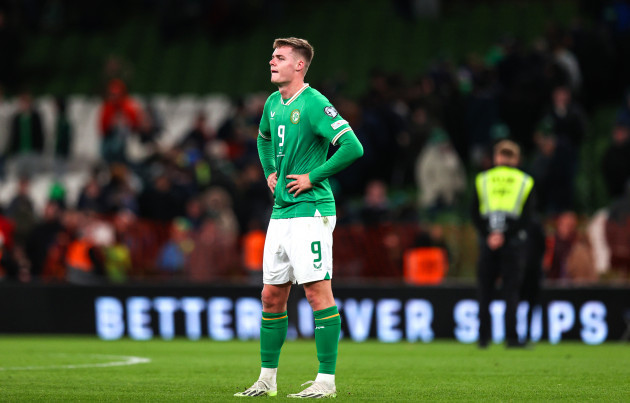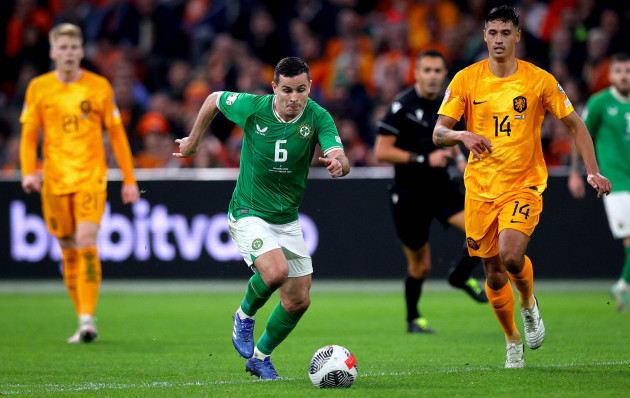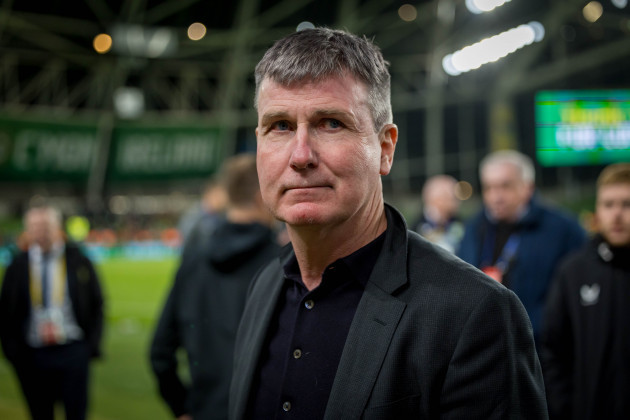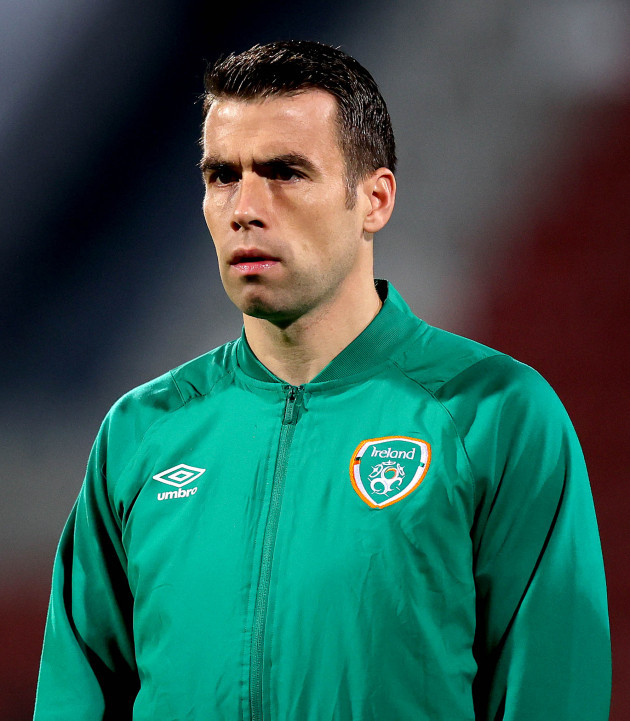1. Goalscoring woes
Ireland’s biggest and most obvious problem for much of Stephen Kenny’s reign was scoring goals.
After an opening 1-1 draw with Bulgaria, Ireland failed to score in the next seven games.
There were mitigating factors such as many players missing out through injury and Covid, but the pattern continued to an extent thereafter.
In 40 games under Kenny, Ireland managed 46 goals, so just over a goal a game on average.
Yet that statistic is inflated by handsome victories over some of the weaker sides in world football.
31 of the 46 goals came against Qatar, Andorra, Azerbaijan, Luxembourg, Lithuania, Armenia, Malta, Latvia, Gibraltar and New Zealand.
Against teams that would be roughly considered superior to or on a par with Ireland, they scored 15 goals from 25 games.
Time and again, this flaw damaged Kenny’s side. They lost the Euros playoff to Slovakia on penalties after a 0-0 draw.
And in their latest Euros campaign, discounting fixtures with Gibraltar, in six matches, they scored two goals.
One of the biggest challenges for the new manager to address is finding a way to score more regularly against stronger opposition.
If you look at the makeup of the last squad Kenny named, there are just four players who have scored at least five goals at international level: James McClean (11 goals from 103 caps), Shane Duffy (7 goals from 60 caps), Alan Browne (five goals from 35 caps) and Callum Robinson (9 goals from 37 caps). McClean has now retired, so he is one individual that can no longer be relied upon.
Besides Robinson, the other attackers from that squad have 12 goals from 61 caps between them.
Evan Ferguson remains a great hope in this regard, but the teenager, who has three goals from 10 appearances, remains raw and far from the finished product.
He will also need help from elsewhere in the team and Ireland’s midfield have not been prolific, to put it mildly. Excluding Browne, the six midfielders in the last squad have managed one goal (scored by Jason Knight) from 98 caps overall.
Too often under Kenny, Ireland simply did not look like scoring.
Part of the problem is down to personnel. Sammie Szmodics remains uncapped but if available, he could be a boost to the squad, as at the time of writing, the Blackburn star is the Championship’s top scorer with 16 goals.
His Blackburn teammate 20-year-old Andrew Moran has caught the eye in the Championship this season and could also figure prominently under the new man, having earned one cap under Kenny.
Leicester City’s English-born Kasey McAteer was also in the process of attaining eligibility towards the end of the Kenny era. The winger, who has four goals from 15 Championship appearances, similarly has the potential to provide Ireland with a greater attacking threat.
So the introduction of the trio above regularly, coupled with the likes of Ferguson and Adam Idah becoming more experienced, should make Ireland a bigger threat in the future.
2. Lack of depth in midfield
There is plenty of potential in the Irish team, partly thanks to work put in by Stephen Kenny and his coaching staff.
26 players were handed competitive debuts under the previous boss and many of those have gone on to become key components of the team
Ireland have one of Europe’s most highly-rated teenage strikers, Evan Ferguson, as well as among English football’s most talented young goalkeepers — Gavin Bazunu. Ferguson is 19 and Bazunu turns 22 later this month so the new manager will be getting both players at a good age with plenty of scope for improvement.
There is decent depth in both positions too. Caoimhin Kelleher, Mark Travers, Adam Idah, Aaron Connolly, Michael Obafemi and Troy Parrott are still players Ireland fans are waiting to see flourish, but at the very least, they will provide the incoming coach with decent alternatives off the bench.
In defence too, there are good options. Nathan Collins, Dara O’Shea and John Egan are all Premier League centre-backs who are first-choice for their clubs when available, while Liam Scales has been having a terrific season at Celtic and left-footed centre-backs like him tend to be coveted in modern footballing systems.
At wing-back/full-back, Festy Ebosele and Ryan Manning have been having encouraging seasons with Udinese and Southampton, though 18-year-old Sam Curtis, who recently joined Nottingham Forest after a meteoric rise at St Patrick’s Athletic, has the potential to provide strong competition on the right and Scales is capable of slotting in on the left if required.
However, the midfield is the biggest problem area.
Josh Cullen, invariably one of the first names on the teamsheet under Kenny, has had a challenging season at Burnley, starting only 12 of their 22 Premier League matches so far.
It has been similarly tough for Jayson Molumby. He has appeared in 24 of West Brom’s 28 Championship matches, though only 12 of those have been starts, with the 24-year-old often used as an impact sub in recent months.
Jason Knight has fared better, featuring in each of Bristol City’s 30 Championship fixtures and starting all but one.
Still, when two out of the three midfielders frequently used under Kenny are not guaranteed starters for their club, it indicates the extent of the problem.
Will Smallbone, capped five times, has been having a good season and playing regularly (25 out of 28 games) for promotion-challenging Southampton and looks like a strong contender to feature more prominently under the new boss.
Alan Browne too continues to be a key player at Preston, featuring in all but two of their Championship matches so far.
Other options, who have been on the fringes until now, include Jamie McGrath, Mark Sykes and Jack Taylor, who remains uncapped but was called up as recently as the Greece game last summer. Whether any of this trio can establish themselves at international level remains to be seen.
3. Style of play
Probably the most contentious topic the new manager will have to address.
Kenny undoubtedly had a more expansive approach than his predecessors like Giovanni Trapattoni, Martin O’Neill and Mick McCarthy.
Tactics such as the playing out from the back would have been unthinkable before his arrival.
However, there has been a degree of exaggeration over the extent to which he changed the set-up.
Ireland still adopted a relatively pragmatic approach when required and it was far from an all-out attack.
In the two Euro qualifiers against the Netherlands, they managed one shot on target in each game.
Against France, they registered 35% possession at home and 32% away with a combined tally of four shots on target.
So while Kenny made Ireland more pleasing to watch than they were previously, he was not as naive or adventurous as some of his critics implied as if he suddenly insisted on the team playing tiki-taka football.
The direct, Jack Charlton-esque style of football more routinely deployed before Kenny’s arrival was producing diminishing returns, thereby prompting the shift in approach.
So perhaps the new man would be better off tweaking the style players have become familiar with under Kenny rather than effectively ripping up the tactics book and beginning again.
Another related big call will be the formation. Kenny played with a four-man defence in his first eight games in charge and either a 4-3-3/4-2-3-1 formation.
Yet Anthony Barry’s brief stint as coach coincided with a change, and for the most part, Ireland played with three centre-backs and two wing-backs thereafter.
It makes sense when you consider the wealth of options at centre-back while also allowing the likes of Matt Doherty and James McClean to play in more attack-minded roles rather than being somewhat restricted at full-back.
As a new era approaches, Ireland’s best options are still at centre-back, though a 4-3-3 would also suit given the increase in options out wide — Mikey Johnston, Chiedozie Ogbene and Kasey McAteer would all be suited to the attacking positions, to feed a central striker like Evan Ferguson or Adam Idah.
It’s not an easy decision and like Kenny, the new coach could end up alternating between the two systems depending on the opposition and the options available to him.
4. Make a call on veteran stars
There are a couple of players on the wrong side of 30 that the new manager will need to make a call on and perhaps definitively end their international careers.
Kenny has begun to phase some of them out already.
McClean is the only player of late to announce his retirement, but Jeff Hendrick faces a battle to add to his 79 caps. The 32-year-old has been used sparingly in his loan spell at Sheffield Wednesday. His last appearance with parent club Newcastle came in December 2021 while his most recent Ireland appearance came as a late substitute in the 3-0 win over Gibraltar back in June.
The outlook is better for 32-year-old Shane Duffy, who has been playing regularly this season, making 27 Championship appearances since joining Norwich in the summer. While he is no longer a guaranteed starter in the Irish team the way he was in the past, the centre-back did feature prominently towards the end of Kenny’s reign.
Having been left out of the side for a period in conjunction with struggles at club level — a short, forgettable stint last season at Fulham for whom he didn’t make a single Premier League start — Duffy did feature from the outset in five of Kenny’s last six matches in charge.
31-year-old John Egan was another favourite under the previous manager but has missed much of this season due to an Achilles tendon injury, last playing for Sheffield United in September.
Moreover, with Scales, O’Shea and Collins all in decent form, it won’t be easy for either Duffy or Egan to keep their place in the starting XI.
Right back is an area of some concern — both Seamus Coleman (35) and Matt Doherty (32) are much closer to the end of their careers than the start. As it stands, they have four Premier League starts between them, although Coleman’s extended absence has been due to injury rather than form.
How often either of these veterans plays will, to some extent, depend on how much progress younger options like Curtis and Ebosele make at their respective clubs.
It’s a similar story on the left-hand side. Robbie Brady (32) and Enda Stevens (33) have 86 caps between them. They have made six and 12 starts respectively in the Championship this season and at the moment, seem like second or third-choice options for Ireland at best. Despite only being 28, Callum O’Dowda also falls into the category of players in danger of being cut adrift. The wing-back has not featured for Cardiff since August, with persistent injury problems limiting his game time for club and country alike in recent years.
Other players have already been effectively discarded by Kenny and are unlikely to return. For example, Ciaran Clark (34) and Conor Hourihane (32) have both been stuck on 36 caps for quite some time. Clark has not played for Ireland since the infamous 1-0 defeat by Luxembourg in March 2021, while Hourihane has not featured since the 3-2 win over Armenia in September 2022.
5. The problematic underage system
Without a doubt, the single biggest issue impacting Irish football.
Of course, the national team coach’s primary responsibility is getting results rather than developing young players.
But his success or lack thereof is always going to depend largely on how many top players the country can produce at underage level.
There have been a couple of significant success stories in recent years like Gavin Bazunu, Nathan Collins and Evan Ferguson.
Yet, by and large, it has been a struggle to produce exceptional players over the last 15 years at least who are collectively good enough to emulate the halcyon days of the Jack Charlton era.
The FAI’s financial issues and the relatively paltry government backing in comparison to sports like horse racing have been covered ad nauseam of late.
However, there has been little sign of significant change and regardless of the identity of its manager, the national team will likely continue to struggle given this ongoing issue.
With the Brexit-enforced rules meaning the majority of Irish youngsters cannot move to England until they are 18 rather than 16 now, it’s more important than ever that top-class footballing facilities are available on these shores.
However, to use England as the obvious comparison, most Irish teams would seriously struggle to match the level of facilities and full-time staff at the disposal of Championship or League One clubs, as former Dundalk boss Vinny Perth, among others, has pointed out.
Albert Einstein famously said that “insanity is doing the same thing over and over and expecting different results,” and no matter how skilled the new manager is, if Irish football continues to neglect and under-invest in youth football, regularly competing at major tournaments will remain a pipe dream and the same disappointing results can be expected.






